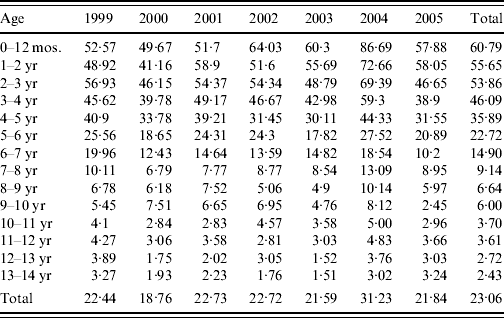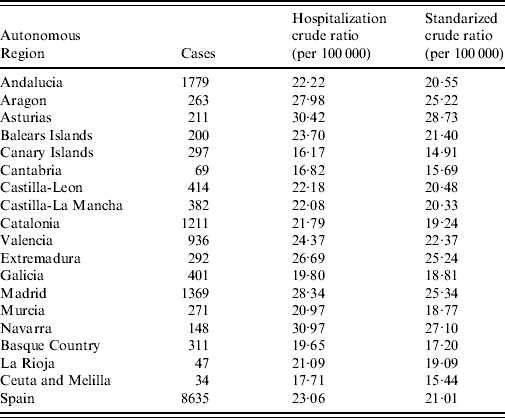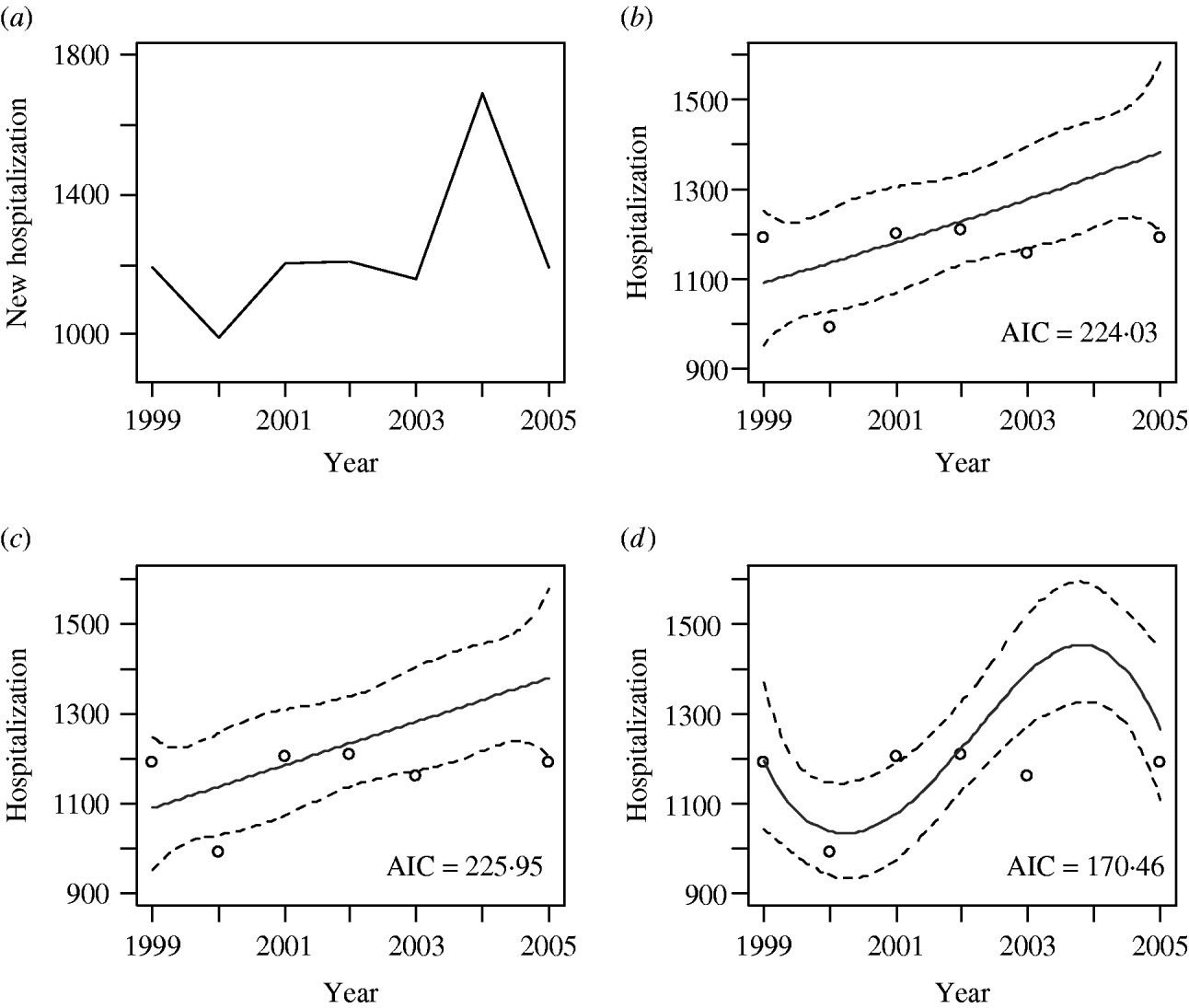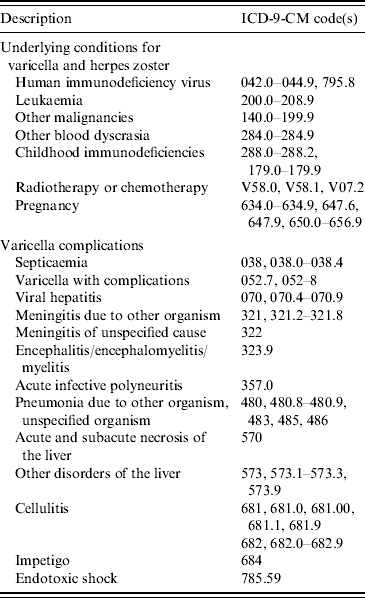INTRODUCTION
Varicella is a highly infectious disease, caused by a small herpesvirus, the varicella herpes zoster virus (VZV). This virus is not only responsible for chickenpox disease but also for herpes zoster disease. Varicella results from a primary infection with VZV. After disease, VZV becomes latent in the dorsal root ganglion and can reactivate, often after a long period, to cause herpes zoster. Transmission occurs from person to person by direct contact, inhalation of aerosols from vesicular fluid of skin lesions of acute varicella or zoster, or infected respiratory tract secretions that also might be aerosolized [Reference Marin1].
Although it is considered as a benign disease, in some cases, particularly in immunocompromised children, neurological (encephalitis, cerebelitis), infectious (cellulitis, abscesses) and haematological (trombocytopenia) complications can develop [Reference Ziebold2].
Lifetime incidence of chickenpox is close to 100% in those areas where vaccination programmes are not implemented [Reference Weaver, Rosenblum and DeAngelis3]. In temperate climates and in the absence of vaccination, 80–98% of individuals acquire the infection by age 15 years [Reference Alfonsi4].
Chickenpox is a vaccine-preventable disease. The United States started its universal varicella vaccination programme in 1995. Since then, incidence, complications and mortality related to varicella have progressively decreased [Reference Vázquez5]. In Spain, varicella vaccination publicly funded programmes were first introduced for the high-risk population in 1997, and later in 2005 the vaccine was included in the vaccination schedule for adolescents (age 11–14 years) who had not suffered the illness. Currently, two of the 17 Autonomous Regions and the two Autonomous Cities (Ceuta and Melilla) of Spain, have implemented varicella vaccination programmes at ages when most varicella cases can be prevented (age 12–15 months). The rest of the Autonomous Regions may implement varicella vaccination programmes at these ages in the near future.
The aim of this study is to describe the burden of hospital admissions related to varicella disease before universal vaccination programmes for children are implemented, in order to provide data for future evaluation of the efficacy of vaccine vaccination programmes.
METHODS
Data on hospital discharges related to varicella were obtained from the Conjunto Mínimo Básico de Datos (CMBD), the surveillance system for hospitalization data. This database used clinical codes from the Spanish version of the Ninth International Classification of Diseases (CIE-9MC) until 2004. Since then the Tenth International Classification of Diseases has been used. It is estimated that CMBD collects 97% of the hospital discharges of the public hospitals and 25% of private clinics [6, Reference Rivero7]. Private hospitals represent a small proportion of all hospital admissions, as almost 100% of the Spanish population is covered by public health-care insurance [Reference Sevilla8].
All paediatric hospitalizations for primary varicella (ICD-9CM 052.0–052.9; in any diagnostic position) that occurred between 1 January 1999 and 31 December 2005 were selected.
Information obtained from the CMBD included dates of admission and discharge, age, sex, average length of stay, and outcome (survival to hospital discharge or death). In Spain a child's paediatric attendance is considered to cover children from birth to age 14 years. Complications of varicella disease were assessed by a search of all those codes associated with varicella-related complications (see Appendix).
A person was considered to have an underlying condition if there was a discharge diagnosis code for at least one of the conditions that increase the risk of severity of varicella (see Appendix).
Statistical methods
Incidence and mortality by varicella for each of the age groups considered were calculated. Mortality, case-fatality rate and average length of stay were also estimated. Global estimations for all the study period and annual estimations were calculated.
Incidence of hospitalizations by varicella was estimated using hospital discharge information obtained from CMBD.
Cases used to calculate incidence of hospitalizations by varicella were obtained from CMBD. Population at risk was obtained from the Spanish census projection and adjusted to the 97·7% of the population covered by the hospitals included in the CMBD. The age-standardized hospitalization rates were calculated for the different Autonomous Regions by using the direct standardization method. The standard reference population of the European Union (EU) was used for this calculation.
Medians and interquartile range (IQR) are presented for the description of quantitative variables, due to asymmetric distribution of the variables.
We developed a polynomial Poisson regression model to assess year-to-year variation, using the annual hospitalization rate as a dependent variable and time as an independent variable. The best-fit model has been chosen on the basis of those than minimize Akaike's Information Criterion (AIC).
We used program R, version 2.6.1 to develop the log-linear model [R Development Core Team, R Foundation for Statistical Computing, Vienna, Austria (http://www.R-project.org.)].
RESULTS
A total of 8635 hospital discharges with a diagnosis of chickenpox were identified during the 7-year study period. Primary or secondary diagnosis represents 94% of the total discharges identified. The paediatric hospitalization rate for the 7-year study period was 23·06 hospitalizations/100 000 population.
The median age was 3 years (IQR 2–5 years). The median length of stay in hospital was 4 days (IQR 3–7 days). Of the total discharges 56·3% were males. In total, 28·9% of those hospitalized were recorded as having complications according to criteria for secondary ICD codes and 3·9% presented underlying conditions. The most common complications were cellulitis (33·0% of all the complications), chickenpox pneumonia (21·8%), other pneumonias (15·9%), encephalitis (12·2%) and other complications (17·1%).
The most common underlying conditions were leukaemia (50·5%), other malignancies (17·1%), childhood immunodeficiencies (16·1%) and other underlying conditions (16·3%). There were no significant differences between males and females either in complications or underlying conditions.
There were 19 cases of death in the study period (13 males, 6 females), which represents a mortality rate and case-fatality rate of 0·05 deaths/100 000 population and 0·22% respectively. Fifteen of these cases presented complications (n=12) and/or underlying conditions (n=5). Pneumonia was the main cause of death, chickenpox pneumonia was diagnosed in three of the deaths and pneumonia associated with other pathogens in five deaths. One case was attributed to leukaemia, another to HIV, and two cases to other malignancies and the last one to other blood dyscrasia.
Table 1 shows hospitalization rates by age and year. Hospitalization rates decrease with age. The highest incidence of hospitalization corresponds to the youngest age group (0–12 months), while the lowest incidence is found in the oldest age group (13–14 years). The incidence of the youngest age group is almost 30-fold higher than the oldest one. In 2004 there was a significant increase of all the age rates, especially in the younger groups.
Table 1. Annual varicella hospitalization rates in Spain (1999–2005)

The median length of hospital stay is similar for all ages, varying between 3 and 5 days (IQR 2–8 days). There are significant differences between length of stay in the Autonomous Regions. The Canary Islands presents the highest median length of stay (6 days, IQR 4–9 days) and Ceuta and Melilla the lowest (2 days, IQR 2–5 days) (Table 2).
Table 2. Paediatric hospitalization crude ratio and age-standardized rates by varicella in Spain (1999–2005)

In order to assess the year-to-year variation, we developed a polynomial Poisson regression model for the different age groups. For the groups with higher rates of hospitalization, the best-fit model is the cubic one, with an AIC=170·46, much lower than in the other models studied.
In the groups with lower hospitalization rates no trend is found, except for the the 13–14 years age group, where a quadratic trend is found, that corresponds to a decrease up to 2002 with a later increase until 2005 (Fig. 1).

Fig. 1. Time trend hospitalization discharges by year in Spain (1999–2005). (a) Annual distribution of hospitalizations, (b) linear model (significant), (c) quadratic model (non-significant), (d) cubic model (significant).
Two models fit with statistical significance, the linear and cubic models. In the linear model we found a small increase in incidence of chickenpox hospitalizations. In the cubic model during the first year of the study period (from 1999 to 2000) there was a significant decrease of hospitalization incidence, followed by an increase (in 2000–2004) and since 2004 to the end of the study period a small decrease in incidence was observed. The cubic model was the best-fit model (AIC 170·46).
All the study groups present the highest hospitalization rate in 2004 (Table 1). Therefore models to study trends were developed including and excluding the 2004 value. Since results were very similar in both cases, we decided to include the value for the trend study.
Asturias and Navarra presented the highest standardized rates, over 27 hospitalizations/100 000 persons. The Canary Islands and Ceuta and Melilla were the regions with the lowest incidence rates, with around 15 hospitalizations/100 000 persons (Table 2).
DISCUSSION
The paediatric hospitalization rate for chickenpox in Spain during the 7-year period between 1999 and 2005 is 23·06/100 000 population. This rate is almost fourfold higher than that reported by Gil et al. for the 1999–2000 period [Reference Gil9] when all the population was considered, reflecting not only the severity of the disease in the early chilhood but also the epidemiology of the disease in warm countries, where most of the cases occur between ages 3 and 9 years. As other authors have established [Reference Fornaro10–Reference Fairley and Miller12], increasing preschool attendance is probably responsible for the shift in the age distribution of varicella. The Spanish rate of paediatric hospitalization is similar to Germany's, estimated as 15·7 hospitalizations/100 000 population (95% CI 6·9–22·3) for a paediatric population that includes children up to age 16 years [Reference Lieser13]. In agreement with our data, the highest rates observed in the literature correspond to the youngest groups. In Scotland, during the 1990s, hospitalization rates for children aged <12 months varied from 56·5 to 125·0 hospitalizations/100 000 population [Reference Bramley and Jone14]. In Canada and the United Kingdom, the hospitalization rates for that age group, between 1979 and 1997 were 71/100 000 and 74/100 000 respectively [Reference Brisson11]. In the United States, varicella hospitalization rates for children aged 0–4 years were 30/100 000 population and 42/100 000 population in 1993 and 1994 respectively [Reference Matthew, Mitesh and Achamyeleh15]. In 1995 varicella vaccine was first recommended and in 1999 hospitalization rates for the 0–4 years age group was 12·7/100 000 population [Reference Matthew, Mitesh and Achamyeleh15].
A varicella vaccine than can be administered to children aged >12 months has been available in Spain since 2003. In 2004 some regions started vaccinating children aged 11 or 12 years, and once the Consejo Interterritorial decided that varicella vaccine should be included in the vaccination schedule of all regions one cohort aged between 11 and 14 years received vaccination. Currently, there are not available data of varicella vaccine coverage in Spain, nor in the different Autonomous Regions. This information would be useful in assessing the immediate impact of the vaccination programme in the varicella hospitalization rate of the 11–14 years age group. In younger groups only herd immunity protection could be expected. Other authors have revealed a decrease in hospitalization and mortality rates in age groups not included in vaccination programmes. In the previously mentioned US study, hospitalization rates declined most substantially among individuals primarily targeted for vaccination (children aged 0–4 years) but decreased among youths aged 5–19 years and also among adults [Reference Matthew, Mitesh and Achamyeleh15]. Nguyen et al. studied varicella mortality rates before and after the onset of varicella vaccine licensure [Reference Nguyen, Jumaan and Seward16]. Their study showed that the rate of death due to varicella fluctuated from 1990 to 1998 and then declined sharply. For the interval from 1990 to 1994, the average number of varicella-related deaths was 145 per year and declined to 66 per year during 1999–2001. This decline was observed in all age groups <50 years, with the greatest reduction (92%) among children aged 1–4 years. Therefore, the literature shows a possible impact of an adolescent varicella vaccination programme on other age groups. Nevertheless, even taking into account the benefits that this programme may provide, a 12–18 months vaccination programme could drastically and quickly decrease the incidence of the disease, and something much more important, decrease the varicella hospitalization and mortality rates in all age groups, particularly those where most of the cases occur, the youngest groups.
The annual hospitalization incidence was lower in 2005 than in 2004 but higher than the rest of the years of the study period. More time will be required before the benefits of varicella vaccination in Spain are seen. Data from 2006 and beyond are likely to show a decrease in the incidence of varicella hospitalization cases.
The median length of stay in hospital is 4 days (IQR 3–7 days). This length of stay is similar in several European countries. In France, the average length of stay is 5 days [Reference Grimprel17], in Holland 5·8–7·3 days (it varies for the different study groups aged between 0 and 14 years) [Reference de Melker18], in Italy 5·7 days (the paediatric population aged between 0 and 16 years) [Reference Azzari19], and Germany 5 days (IQR 3–8 days) (study population aged between 0 and 16 years) [Reference Lieser13].
We found certain differences in the incidence of hospitalizations between the different Autonomous Regions. These differences are similar to those found by Gil et al. for the study period between 1995 and 2000 [Reference Gil20]. One of the most remarkable changes in the two study periods concerns the incidence of varicella hospitalizations in La Rioja Autonomous Region. During the 1995–2000 period this region presented the highest ‘paediatric’ (considered as being ⩽10 years of age) rate of all the Autonomous Regions, but in 1999–2005 it fell to thirteenth. Asturias, Navarra, and Madrid present high relative incidences in both studies, while the Canary Islands and Basque Country remain as two of the Autonomous Regions with lowest incidence rates.
Results showed a peak of varicella hospitalizations in 2004. These could be easily explained if an outbreak of varicella had occurred. In Spain varicella cases are mandatory notifiable to the public health authorities. There is a weekly bulletin where all the mandatory notifiable cases of infectious diseases are published [21]. This is a useful way of controlling epidemiological outbreaks. Data from 2004 reveal an increase in the incidence of chickenpox in Spain, but not enough to be considered as an epidemic outbreak. An epidemiology index between 0·74 and 1·24 indicates a normal incidence. Although the epidemiology index of 1·19 in 2004, is considered as a normal incidence, the rest of the indexes for the study period are much lower, reaching the lowest value in 2005, when the epidemiology index fell to 0·74, which was considered as a low-incidence year. Thereby there is a correlation between the highest hospitalization rate during the study period and the highest incidence.
A study of the incidence of hospitalization trends shows a linear positive slope that leads us to believe that there is a small increase of chickenpox hospitalizations over the last few years. However, the best fit of the cubic model implies that an increased incidence of varicella hospitalizations can not be established.
Hospitalization discharges are useful tools to evaluate the epidemiology of some diseases and their complications. However, they have some limitations, including some potential biases associated to coding or the assumption of causality between disease and potential complications that could result in misclassification. Varicella is a common and easily recognizable disease, so this misclassification may be lower than for other diagnoses. Another possible limitation of the study is the ‘any position diagnosis’ criteria for the selection of chickenpox discharges. Ninety-four per cent of the discharges identified correspond to primary or secondary diagnoses of varicella, confirming the use of an ‘any position diagnosis’ search of the CMBD database as a valid way to obtain hospitalizations caused by varicella. Moreover, in this age group missclassification of varicella is unlikely, since herpes zoster generally affects older age groups.
Our data highlight the important burden of paediatric varicella hospitalization in Spain, showing the highest values for the youngest children. The implementation of varicella vaccination programmes for children aged 12–18 months could substantially reduce the number of hospitalized children and adults in the near future.
ACKNOWLEDGEMENTS
The authors are grateful to the Subdirección General del Instituto de Información Sanitaria (Ministerio de Sanidad y Consumo) for providing the information on which this study is based.
APPENDIX

DECLARATION OF INTEREST
None.







